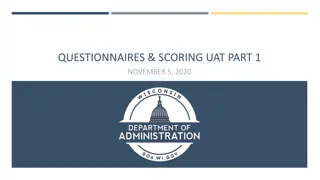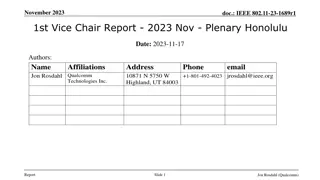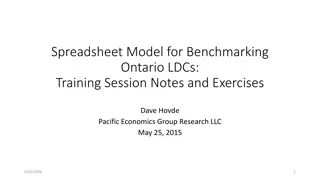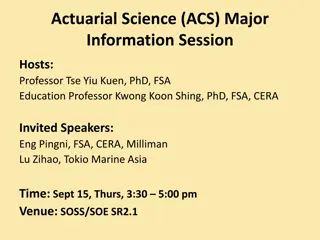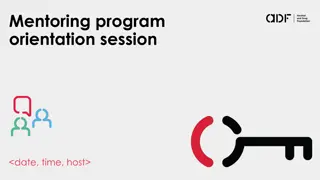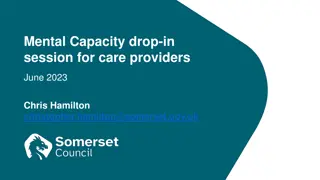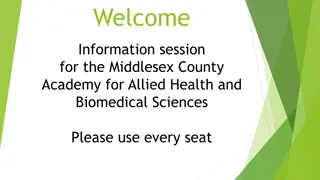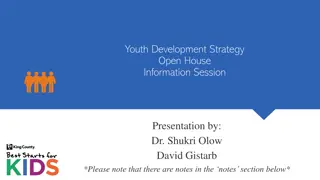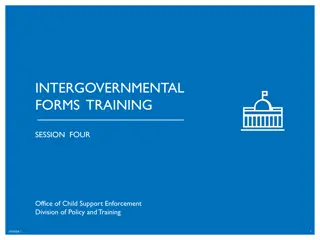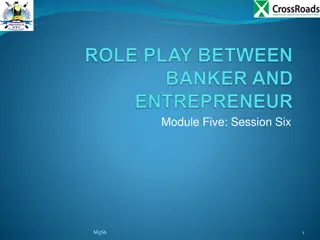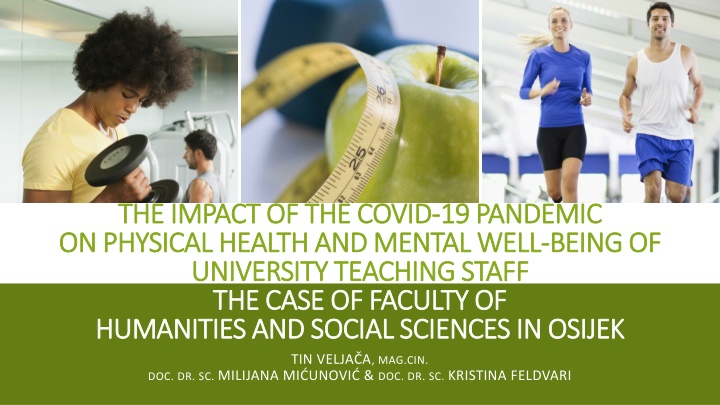
Impact of COVID-19 Pandemic on Physical and Mental Well-being of University Teaching Staff
Explore the impact of the COVID-19 pandemic on the physical and mental health of university teaching staff in the Faculty of Humanities and Social Sciences in Osijek. Understand the lifestyle habits, dietary patterns, physical activity, and mental health challenges faced by educators during the pandemic.
Download Presentation

Please find below an Image/Link to download the presentation.
The content on the website is provided AS IS for your information and personal use only. It may not be sold, licensed, or shared on other websites without obtaining consent from the author. If you encounter any issues during the download, it is possible that the publisher has removed the file from their server.
You are allowed to download the files provided on this website for personal or commercial use, subject to the condition that they are used lawfully. All files are the property of their respective owners.
The content on the website is provided AS IS for your information and personal use only. It may not be sold, licensed, or shared on other websites without obtaining consent from the author.
E N D
Presentation Transcript
THE IMPACT OF THE COVID THE IMPACT OF THE COVID- -19 PANDEMIC ON PHYSICAL HEALTH AND MENTAL ON PHYSICAL HEALTH AND MENTALWELL UNIVERSITY TEACHING STAFF UNIVERSITY TEACHING STAFF THE CASE OF FACULTY OF THE CASE OF FACULTY OF HUMANITIES AND SOCIAL SCIENCES IN OSIJEK HUMANITIES AND SOCIAL SCIENCES IN OSIJEK 19 PANDEMIC WELL- -BEING OF BEING OF TIN VELJA A, MAG.CIN. DOC. DR. SC. MILIJANA MI UNOVI & DOC. DR. SC. KRISTINA FELDVARI
LITERATURE REVIEW MOST COMMON SYMPTOMS OF MOST COMMON SYMPTOMS OF SOCIO SOCIO- -EMOTIONAL EMOTIONAL IMPACT OF NEW WORK CONDITIONS IMPACT OF NEW WORK CONDITIONS decline in physical activity increased food intake rise in stress levels and increased burnout syndrome
PHYSICAL PHYSICAL ACTIVITY ACTIVITY HABITS HABITS 38% no activity at all Eurobarometer PA 2019 44% 2022 38% 36% 5 or more hours in front of screen 60% sleeping disorder CRO - PA 2019 27% 2022 30% (Mart nez-de-Quel et al., 2021; Maugeri et al., 2020; Ismail et al.,2020) (European Commission, 2022)
NUTRITION HABITS NUTRITION HABITS - intake of water, fruits, vegetables, and low-calorie drinks - intake of high-calorie food - emotional and compulsive overeating (Di Renzo et al., 2020; Ismail et al., 2020; Poskute, Nzesi, Geliebter, 2021; Coulthard et al., 2021)
MENTAL HEALTH MENTAL HEALTH COVID-19 and mental health (in general) > stress, anxiety, depression, sleep disorder, burnout syndrome, substance abuse, etc. (Kumar & Nayar, 2020; Maugeri et al., 2020; Pfefferbaum & North, 2020; Eurostat: Statistics explained, 2022; World Health Organization, 2022c) common psychological symptoms amongst university teachers during COVID-19: stress, anxiety, depression and burnout (Casimiro Urcos et al., 2020; Idris et al., 2021; Ozamiz-Etxebarria et al., 2021; Scanlan & Savill-Smith, 2021; Savill-Smith & Scanlan 2022) different stressors: increased workload, deadlines, lack of control over work, irregular hours, maintaining a work/life balance, stress of online teaching, social isolation, lack of timely government guidance (Education Support, 2020b; MacIntyre, Gregersen & Mercer, 2020; Idris et al., 2021; Scanlan & Savill-Smith, 2021) three most common factors of anxiety, stress and burnout in HE teachers(Merchant & Lurie, 2020; Daumiller et al., 2021; Fern ndez-Su rez et al., 2021; Filho et al., 2021; Carr et al., 2022; Galea et al., 2022): a) information overload (COVID-19 pandemic), b) additional heavy workload and reshape of work conditions, c) social isolation and physical distancing
OUR RESEARCH OUR RESEARCH RESEARCH QUESTIONS RESEARCH QUESTIONS 1) What were the lifestyle habits, dietary habits, fitness (exercise) habits and habits for mental well-being of the faculty teaching staff prior to the COVID-19 pandemic, during the COVID-19 pandemic and in the post-COVID.19 period? What are the newly developed dietary habits, fitness (exercise) habits and habits for mental well-being (e.g. increasing or decreasing exercise, introducing healthy dietary habits or eating junk food, cultivating mental well-being more or neglecting mental well-being)? 2) What was the impact of social isolation and physical distancing on physical activity and dietary habits and mental well-being 3) What was the impact of the information overload concerning the COVID-19 pandemic and online classes/remote work mental well-being of the faculty teaching staff? 4) Did the faculty teaching staff experience the burnout syndrome due to work overload during the COVID-19 pandemic and transition to online teaching/remote work, and was the impact of healthy dietary habits, regular exercise and cultivation of mental well-being on dealing with the burnout syndrome?
METHOD METHOD Online survey (LimeSurvey) 3 parts: 1) lifestyle and exercise; 2) dietary habits; 3) mental health), 31 questions (close-ended questions, dichotomous questions, multiple choice questions, scaled questions, matrix questions, and contingency questions) Questionnaire 4 main themes: (sociodemographic characteristics) 1) pre-COVID-19 experience with diet, exercise and mental well-being 2) experience with diet, exercise and mental well-being during COVID-19 pandemic the impact of social isolation and distancing on physical well-being (exercise) the impact of information overload concerning COVID-19 pandemic and online teaching/remote work on mental well- being 3) experience with diet, exercise and mental well-being in the post-COVID-19 period 4) the impact of healthy dietary habits, regular exercise and cultivation of mental well-being on dealing with the burnout syndrome
SAMPLE SAMPLE the teaching staff at Faculty of Humanities and Social Sciences, University of Osijek, including all ranks and titles 53 responses! (out of 167) (2 calls!) questionnaire granularity additional comparative research (Faculty of Kinesiology) interviews (2. phase)
negative impact of lockdown and self-isolation measures on PA and exercise 29% negative impact of pandemic on PA and exercise in general 30% spent more time outside the house and in nature 38% had more time for physical activities and exercise 40% consumed more calories than before 39% often practiced snacking between meals 32% began to emotionally overeat 17% gained extra weight during the pandemic 32%
ability to work productively, collaborate and contribute to the working community ability to cope with information overload 13 POORLY 4 POORLY B D A B D A 13 EXCELLENT 26 EXCELLENT 23 POORLY 4 POORLY 13 19 EXCELLENT EXCELLENT 2 0 POORLY POORLY 24 36 EXCELLENT EXCELLENT 0 5 10 15 20 25 30 0 5 10 15 20 25 30 35 40
burnout syndrome at the workplace (55%) ability to cope with workplace burnout 13 65.5% B D A 15 15 19 58.6% 4 21 55.2% 0 5 10 15 20 25 before during after poorly excellent
intentionally followed information and content about the COVID-19 - 38% once/day, 41% few times/day information and conversations on the topic of the COVID-19 caused me a feeling of information overload - 43% information and conversations on the topic of the COVID-19 caused me information anxiety - 49% % Main negative aspects of distance learning and the online way of working and performance of work tasks and business productivity 1. The amount of time spent with the computer 2. Social isolation 3. Difficulty distinguishing between work and free time
LIFESTYLE, HABITS LIFESTYLE, HABITS AND AND WELL WELL- -BEING BEING negative impact on overall well-being and satisfaction 47% spent less time socializing with others 72% generally spent more time sitting than before 53% more time in front of computer/TV/mobile screen for entertainment (e.g. watching Netflix) - 56% spent more time in front of the computer/mobile screen - work obligations required it - 81% quality of life declined 45%
CONCLUDING DISCUSSION CONCLUDING DISCUSSION the COVID-19 pandemic has had a discernible impact on the exercise, diet and lifestyle of HE teachers ability to successfully cope with information overload and information anxiety during and after the pandemic has partially declined online teaching and remote work led to partial decline in work productivity and cooperation with colleagues during and after the pandemic though the feeling of burnout has declined during and after the pandemic, the ability to cope with the burnout has also declined the most common factors impacting teachers physical and mental well-being during the pandemic were the amount of time spent in front of the computer due to online classes and remote work, blurred lines between work time and free time, and social isolation



